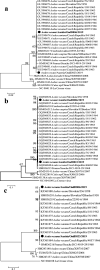The transmission ecology of Tahyna orthobunyavirus in Austria as revealed by longitudinal mosquito sampling and blood meal analysis in floodplain habitats
- PMID: 34717742
- PMCID: PMC8556901
- DOI: 10.1186/s13071-021-05061-1
The transmission ecology of Tahyna orthobunyavirus in Austria as revealed by longitudinal mosquito sampling and blood meal analysis in floodplain habitats
Abstract
Background: Tahyna orthobunyavirus (TAHV) is a mosquito-borne virus that may cause mild flu-like symptoms or neurological symptoms in humans. It is historically associated with floodplain habitats in Central Europe, and the mammalophilic floodwater mosquito, Aedes vexans, is thought to be the principal vector. There are few contemporary reports of TAHV transmission ecology within mosquitoes or their vertebrate hosts, and virus infections are rarely reported (and probably seldom diagnosed). The objectives of this study were to survey the mosquito population for TAHV in three floodwater habitats and describe host usage by the predominant floodwater mosquito species to potentially define TAHV transmission at these foci.
Methods: We performed longitudinal mosquito sampling along three major rivers in eastern Austria to characterize the mosquito community in floodplain habitats, and tested for the presence of TAHV in pools of mosquitoes. We characterized TAHV rescued from mosquito pool homogenate by sequencing. We surveyed mosquito host selection by analyzing mosquito blood meals.
Results: We identified TAHV in two pools of Ae. vexans captured along the Leitha River. This mosquito, and other floodwater mosquitoes, used large mammals (red deer, roe deer, wild boar) as their hosts. The sequence of the rescued virus was remarkably similar to other TAHV isolates from the region, dating back to the first isolate of TAHV in 1958.
Conclusions: In general, we confirmed that TAHV is most likely being transmitted by Ae. vexans, although the precise contribution of vertebrate-amplifying hosts to the ecological maintenance of the virus is unclear. The pattern of host selection matches the estimated exposure of the same large mammal species in the region to TAHV based on a recent serosurvey, but hares were also hosts at the site where TAHV was detected. We also confirm humans as hosts of two floodwater mosquito species, providing a potential mechanism for spillover of TAHV or other mosquito-borne viruses.
Keywords: Arbovirus; Austria; Blood meal analysis; Mosquito; Orthobunyavirus; Transmission ecology.
© 2021. The Author(s).
Conflict of interest statement
The authors declare that they have no competing interests.
Figures



Similar articles
-
Arbovirus Screening in Mosquitoes in Emilia-Romagna (Italy, 2021) and Isolation of Tahyna Virus.Microbiol Spectr. 2022 Oct 26;10(5):e0158722. doi: 10.1128/spectrum.01587-22. Epub 2022 Sep 27. Microbiol Spectr. 2022. PMID: 36165787 Free PMC article.
-
Ťahyňa virus-A widespread, but neglected mosquito-borne virus in Europe.Zoonoses Public Health. 2023 Aug;70(5):371-382. doi: 10.1111/zph.13042. Epub 2023 May 2. Zoonoses Public Health. 2023. PMID: 37128975 Review.
-
Ecology and geography of Cache Valley virus assessed using ecological niche modeling.Parasit Vectors. 2024 Jun 26;17(1):270. doi: 10.1186/s13071-024-06344-z. Parasit Vectors. 2024. PMID: 38926834 Free PMC article.
-
Serological surveillance for Tahyna virus (California encephalitis orthobunyavirus, Peribunyaviridae) neutralizing antibodies in wild ungulates in Austria, Hungary and Romania.Zoonoses Public Health. 2018 Jun;65(4):459-463. doi: 10.1111/zph.12457. Epub 2018 Mar 8. Zoonoses Public Health. 2018. PMID: 29516663
-
Mosquito-borne viruses in western Europe: a review.J Vector Ecol. 1999 Jun;24(1):1-39. J Vector Ecol. 1999. PMID: 10436876 Review.
Cited by
-
Surveillance of Tahyna Orthobunyavirus in Urban Areas in Croatia-The "One Health" Approach.Trop Med Infect Dis. 2022 Oct 20;7(10):320. doi: 10.3390/tropicalmed7100320. Trop Med Infect Dis. 2022. PMID: 36288061 Free PMC article.
-
Vector competence and immune response of Aedes aegypti for Ebinur Lake virus, a newly classified mosquito-borne orthobunyavirus.PLoS Negl Trop Dis. 2022 Jul 18;16(7):e0010642. doi: 10.1371/journal.pntd.0010642. eCollection 2022 Jul. PLoS Negl Trop Dis. 2022. PMID: 35849620 Free PMC article.
-
Arbovirus Screening in Mosquitoes in Emilia-Romagna (Italy, 2021) and Isolation of Tahyna Virus.Microbiol Spectr. 2022 Oct 26;10(5):e0158722. doi: 10.1128/spectrum.01587-22. Epub 2022 Sep 27. Microbiol Spectr. 2022. PMID: 36165787 Free PMC article.
-
Detection of Tahyna Orthobunyavirus-Neutralizing Antibodies in Patients with Neuroinvasive Disease in Croatia.Microorganisms. 2022 Jul 18;10(7):1443. doi: 10.3390/microorganisms10071443. Microorganisms. 2022. PMID: 35889162 Free PMC article.
-
Evaluating the mosquito vector range for two orthobunyaviruses: Oya virus and Ebinur Lake virus.Parasit Vectors. 2024 May 7;17(1):204. doi: 10.1186/s13071-024-06295-5. Parasit Vectors. 2024. PMID: 38715075 Free PMC article.
References
-
- Bardos V, Danielova V. The Tahyna virus–a virus isolated from mosquitoes in Czechoslovakia. J Hyg Epidemiol Microbiol Immunol. 1959;3:264–276. - PubMed
-
- Likar M, Casals J. Isolation from man in Slovenia of a virus belonging to the California complex of arthropodborne viruses. Nature. 1963;197:1131. - PubMed
-
- Medek M, Bardos V, Hubalek Z, Kania V. Isolation of Tahyna virus from the blood of sick children. Cesk Pediatr. 1976;31(11):617–619. - PubMed
-
- Simkova A, Sluka F. Isolation of Tahyna virus from the blood of a case of influenza-like disease. Acta Virol. 1973;17(1):94. - PubMed
-
- Sluka F. Recognition of clinical forms of Valtice fever, a new arbovirus infection. Wien Med Wochenschr. 1969;119(45):765–769. - PubMed
MeSH terms
LinkOut - more resources
Full Text Sources
Molecular Biology Databases

